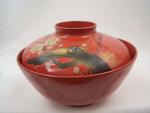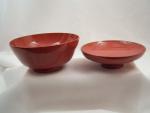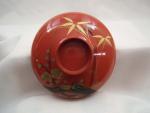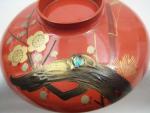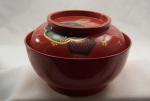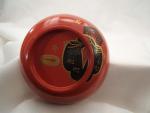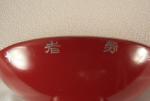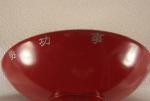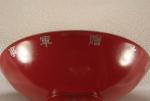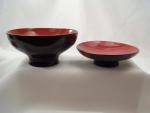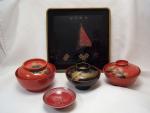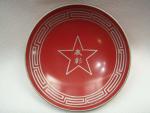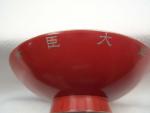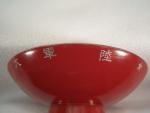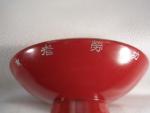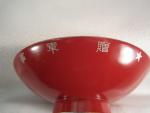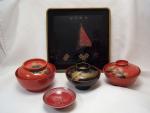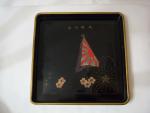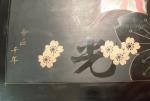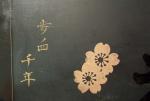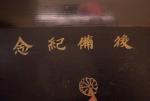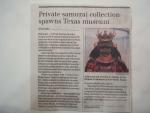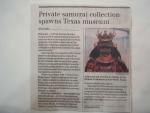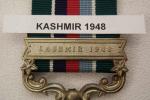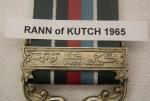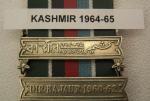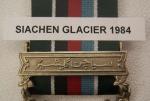-
Posts
6,486 -
Joined
-
Last visited
-
Days Won
10
Content Type
Profiles
Forums
Blogs
Gallery
Events
Store
Everything posted by Brian Wolfe
-
Thanks Rich, I would be lost without your kind assistance. Regards Brian
-
Hello everyone, This is the last piece of the grouping from the weekend. that I need help with..I promise. The bowl measures 4 3/4 inches in diameter and the sake cup/cover measures a little over 4 1/4 inches in diameter. The sake cup has some very nice decoration and the thing that caught my eye is how the artist used extra thick paint and embedded a piece of abalone shell in it. The bowl has three lines of kanji and I am hoping that this will lead to discovering the age of the set. Other than what the writing on the bowl's bottom will reveal there is nothing telling me that this is or is not from the WWII era. The seller thought it was made in the mid 1950s. What are your opinions? These next two photos shows the bottom of the sake cup. This last photo shows the writing on the bottom of the bowl. This, I am hoping, will tell us more about the cup and bowl set. Thank you to everyone for taking the time to assist me. I really like the collecting of Japanese artifacts but when it comes to the translations I am completely lost. Regards Brian
-
Hello EVerone, Here is a 5 inch bowl and 4 3/4 inch sake cup cover that I would like your opinions on. There are no markings on the cup or bowl but the sake cup features a t'suba and other guard parts of a katana. This would lead me to think along the lines of a martial theme. Do you think this would have been made during the war years. The dealer had a tag that he made stating it was from the WWI or WWII period. I would think if it were from either period it would be the Second World War and not the first. What do you think? Regards Brian
-
It looks like I made an error in posting those last three images so I will try again here. Regards Brian
-
Hello again, Here is a bowl and sake cup that came with the hoard from the weekend. There is no writing on this pair only a scene and the Nation Flag of Japan. The bowl is 4 3/4 inches in diameter and the sake cup is just under 4 inches in dia. The dealer thought these belonged to the tray but I doubt that very much due to condition if nothing else. Do you think this is from the WWII era or post war? I really like the scene. If the flag were of the rising sun I would say WWII era but what about the National Flag; I've seen the two together on war era cups, Thanks again for your help. In this photo the distortion is due only to the photography and the shape is actually perfect in "real" life. This is a photo of the bottom of the sake cup showing the scene and the National Flag of Japan in the centre. Regards Brian
-
Hello everyone, Another item from the lot I purchased on the weekend is the 3 ½ inch sake cup which I need assitance in translating. From the star I am assuming this was an army sake cup. This is the writing on the insde of the cup. I have read that the writitng on the inside is usually the recipient's name while those found on the bottom is the maker's name. Around the rim is what appears to be two messages separated by stars. I have tried to show each message two kanji at a time. Here is the first message. The second message is next. ' alt='' class='ipsImage' width="1000px" height="749px"> ' alt='' class='ipsImage' width="1000px" height="749px"> Thank you very much for your help. Regards Brian
-
Hello Everyone, While at a gun show on the weekend I noticed a group of Japanese items on a dealer’s table that I’ve noticed there for the past several shows. I never looked at this grouping too closely as his prices were two or three times what they should have been. Each show he seemed to push these items farther to the back edge of his table and there was always something partially covering them; a photo, book or uniform for example. This time I decided to at least look at the pieces more closely. There was a nice lacquered sake cup that was priced below market value that caught my eye. Upon picking up the cup the dealer, seeing my interest, said that he would give me a great deal if I wanted the lot. I asked; he offered; I fainted. Well I didn’t faint but I certainly couldn’t hide my excitement at his price. It was obvious that he had kept these items on his table from show to show long enough and wanted to get some of his money back from them. I usually purchase my Japanese items, medals, sake cups, merit award etc. from known dealers, some who are members here. This assures me that some if not all of the translations are done for me at the time of purchase. This seller seldom purchased anything such as this so was of no help to me. So I am coming to the membership for assistance with my dilemma. I have gone through the few books I have on the subject and checked out a very good site on the internet, (Rich’s web page; I highly recommend this site to all). In the end I am left no more enlightened than when I started. If you could please give me some assistance it would be greatly appreciated. I will post each of the five items in a separate post to help avoid confusion (mine) and note in the subject line 1/5, 2/5 and so on. Thank you in advance for any assistance you can extend to me. Regards Brian The first photo is of the group I purchased. For me a real treasure trove. In this post I would like to deal with just the Sake Cup Tray. There are two images of kanji that were made at the same time as the tray and therefore would no doubt (in my mine) be generic to all trays sold by this manufacturer. This is a close-up of the next translation I would like help with. Here is a close-up of the writing at the top of the tray. Thanks again for any help you can give me. Regards Brian
-

Japan Phaleristical Mistakes in "Letters from Iwo Jima"
Brian Wolfe replied to JapanX's topic in Japan
Good eye Nick. I'm not sure how many other members have seen this film but I liked it well enough to purchase the DVD. An excellent film despite the errors in the medals. Still you would have thought that they could have put more attention to getting these details correct. Thanks for pointing this out. Regards Brian -

lancers helmet
Brian Wolfe replied to blueman's topic in Great Britain: Militaria: Badges, Uniforms & Equipment
Hi Stuart, Good to see you on the forum. Spelling? I messed up your first name but have now edited the error. Welcome back. Regards Brian -

lancers helmet
Brian Wolfe replied to blueman's topic in Great Britain: Militaria: Badges, Uniforms & Equipment
I do wonder if this is a case where the helmet was "refitted" in order to use as a stage prop or as a cheaper alternative to an authentic piece used as a decorator item. It is frustrating when these reach an auction house and are released onto the collector market. Well done pjak and Stuart. Regards Brian -
Thanks Nick. Regards Brian
-
Hello Everyone, I thought that members interested in armour and especially Japanese Armour, as I am, might find this article from our local paper, The Waterloo Region Record, interesting. If by our good luck any members might just be in the area where this is being displayed it would be great if some photos could find their way back here to the forum. Regards Brian
-
Hello Everyone, I've always had an interest in Japanese armour and I thought that since we are all interested in Japanese items in this section that I would post it for your interest. It's not that significant an article so I am "pinning" it so that it can be more easily found and removed later. I'd rather not keep a lot of trivial articles in this section if it can be avoided. Regards Brian
-
This is the first time I have heard of these and I would recommend anyone to view the whole video. Thank you very much for posting this Taz. Regards Brian
-

The Tamgha-i-Difaa, Pakistan's General Service Medal
Brian Wolfe replied to Brian Wolfe's topic in South Asia
Hello Hugh, Thanks for your comments. I would be more than happy if both sides had issues with some points, that way I would feel that I have remained as neutral as possible. I've read many accounts of these conflicts by authors from both sides and about the only thing they seem to agree on is that there were indeed conflicts. If I have fallen prey to propaganda from either side then I apologize as there was no intention to show preference. Regards Brian -
Pakistan’s General Service Medal Throughout the history of modern warfare most countries have awarded medals to their military personnel for service during times of war. In the past, major wars were often defined by one decisive battle. At times that final battle defined the whole war, as in the Battle of Waterloo, for which the British, among others, struck a medal. In time, as conflicts became shorter and more isolated to specific brief campaigns and/or punitive raids, there was still a need to recognize the service by the military. The striking of a separate medal for each small conflict would have been too expensive and the resulting massive groups of these campaign medals being too heavy to even wear on a uniform. The answer was to issue a General Service Medal and affix bars or clasps to the ribbon for each campaign. Most countries have implemented a general service medal and Pakistan is no exception. The general service medal of Pakistan is called the, Tamgha-i-Difaa In the photo below we see the obverse and the reverse. The Clasps As we look at the different clasps (or bars if you prefer) please note that I have tended to stay away from the usual list of casualties and loss of material and focused more on the individual conflict itself along with a brief overview of the actions. I have also attempted to temper the view of the conflicts, resulting in these clasps, to as much of a neutral attitude as possible rather than attempting to weigh the views of both sides (Pakistan and India) and then draw an uneducated conclusion; knowing full well the difficulty of either side to remain completely objective and unbiased. Kashmir 1948 This clasp was awarded for service during the Indo-Pakistani War of 1947-48, also known as the First Kashmir War, which was fought over and in the Princely State of Kashmir and Jammu. Muslim tribal militias backed by the Pakistani Army crossed the border claiming it to be needed to quell a rebellion in the Princely State. Originally this was a conflict between the Princely State and the Muslim Militias, however as Pakistan took an ever greater part in the action the Hindu ruler, Hari Singh, fearing a Muslim uprising, requested assistance from India. In return he agreed to join the Union of India. After several engagements between India and Pakistan the Indian Prime Minister, Jawaharlal Nehru, requested the UN to intervene and a cease fire was arranged in December of 1948. The war resulted in India claiming the bulk of the area which included the regions which were best suited to agriculture and also containing the largest percentage of the population. Dir Bajaur 1960-62 After the creation of Pakistan in 1947 several small areas near the Afghanistan border such as Bajaur and Princely States such as Dir remained independent though with agreements which loosely tied them to Pakistan. Shortly after these agreements were signed armed insurgents funded by Afghanistan started to infiltrate these areas. The goal of these tactics was to drive the areas, in this case, Dir and Bajaur, to seek assistance from Afghanistan and thereby secure the areas under Afghanistan’s rule. For several months the forces of these small independent states resisted the insurgents which tried the patience of the Afghanistan government causing them to send in their regular army. This in turn caused the ruler of Bajaur, the Nawab of Khar, to request assistance from the Pakistani Army. The Afghani Army was forced to retreat and the Pakistani military built forts along the border and made a commitment to station troops permanently in Dir and Bajaur, along with the other areas and states along the border. This whole area is now under Pakistan’s Federally Administered Tribal Areas (FATA) agency. Rann of Kutch 1965 The Rann of Kutch is an area along the border between Pakistan and India in the Indian State of Gujarat. Rann itself is a low area on the Arabian Sea coast and alternates between a salt flat and a tidal basin. This disputed area was part of the border negotiations and in 1960 it was agreed that since there had been no agreement reached that the area would be left as it was until future discussions and a resolution could be reached. In 1965 Pakistan moved American supplied tanks into the area, under protest from the United States; the protests were, of course, ignored. The reasons for this move on the part of Pakistan was to test the American resolve that armour supplied to Pakistan would not be used to attack Indian territory. A more tactical reason for this decision was to attract Indian forces from the North and away from Kashmir where attacks had been planned by Pakistan in the near future. India first noticed increased Pakistani Border Police patrols probing deeper and deeper into India and followed by the establishment of a line of forts, again well within India territory. Pakistan was very confident in their actions based on what they viewed as a demoralising defeat of Indian forces by China in 1962 which would make India reluctant to engage in another war anytime soon. The Indians were not about to suffer another humiliating defeat and counter-attacked. In the end of this five month long war (April to August) a tribunal of the UN was requested by both parties and a settlement reached. The small gains by Pakistan, of Indian territories, gave them confidence that they could defeat India in a full scale war. This would prove to be a huge misinterpretation of the Indian resolve as will be seen next. Kashmir 1964-65 Pakistan and India were once again to see conflict in Kashmir in1965 for what would become to be known as the Second Kashmir War. The war itself was the end result of several border skirmishes and was, for the most part, carried on along the border of the two countries. The UN stepped in after five months of intense fighting mandating a ceasefire between the two countries. As in 1948 (First Kashmir War) it was an issue of control of the area of Jammu and Kashmir this time with thousands of Pakistani soldiers, dressed as local inhabitants, infiltrating the area. The local inhabitants, rather than siding with the Pakistanis alerted the Indian government to what was taking place and India responded by crossing into Kashmir to engage the enemy. After a back and forth slogging match, escalating from infantry engagements to armour then air strikes, India decided to try a different tactic as both sides seemed to be caught up in a never-ending conflict. This tactic was to open up another front in the Pakistani Punjab. The resulting second front drew Pakistani forces away from the first front in Kashmir to engage the enemy on this new front; resulting in a slight relief of the pressure on Indian forces in Kashmir. Even with the new front and the relocation of some Pakistani forces to the Punjab the war itself was still in a state of virtual stalemate. In the end India held more of Pakistan’s territory (about 700 square miles) than Pakistan did of Indian territory (approximately 200 sq. miles). In a further reflection of the 1948 War India held the more agriculturally significant land while Pakistan gained mostly desert areas. This conflict is an interesting study in what can take place when miscalculation, false assumptions and lack of intelligence gathering takes place. The Pakistanis believed that the indigenous population, being predominately Islamic would support any insurgence by Muslim Pakistan. This turned out to be a huge miscalculation based on pure speculation. India in turn failed to monitor the area that had proven to be a sore spot between the two nations for years and thereby allowed the infiltration of thousands of Pakistani soldiers. Pakistani military leaders were over confident in the misconception that India would be defeated in a rapid single strike. Perhaps this may have actually worked, however they were discovered before any such action could take place. In addition to this Pakistan did not consider that Indian military planners would open a second front and their lack of foresight and under-estimation of India’s military minds caused the withdrawal of the much needed men and material from the Kashmir front to strengthen the new front in the Punjab. Perhaps in defence of Pakistan it should be noted that there appeared to be an air of caution on the part of Pakistan that this should not escalate into a full blown war between the two nations. It is speculative to suggest that this fear of escalation may have played a part, no matter how small, in Pakistan’s political and military leaders not pressing the engagements harder than they did. This last paragraph is offered only as speculation and the reader is encouraged to research deeper into the Kashmir Wars to draw their own conclusions. Siachen Glacier 1984 (to present) The Siachen Glacier area lies in Northern India and borders India, Pakistan and China. India and Pakistan both claim sovereignty over the region and this resulted in India in1984 launching a large military operation that resulted in their gaining control of this area ever since. Since 1984 there have been many skirmishes between Pakistani and Indian forces but, as yet, no major battles or war. This area is perhaps the most inhospitable on the planet to attempt to carry out military operations. With both countries maintaining a permanent military presence there have been more casualties caused by the harsh conditions than from enemy engagements. This is due to the Siachen Glacier area being 20,000 feet above sea level. Interestingly enough both sides would like to withdraw from the area and plans were under way by India to do so. However due to Pakistani incursions during the 1999 Kargil War [see below] these plans were terminated. This leaves the Siachen Glacier the highest altitude in the world where an ongoing military stand-off is taking place. Access is so difficult that, other than helicopters, both sides still find themselves relying on mule transport. Indian medals can be found with the recipient’s regiment given as, ASC AT (Army Service Corps, Animal Transport). [ 1999 Kargil War: Fought between India and Pakistan from May to July, 1999, once again in an area of Kashmir. Pakistan withdrew as part of an agreement that the United States would mediate the dispute. India remains in control of the area]. I hope you found this article on Pakistan’s General Service Medal the Tamgha-i-Difaa, its clasps and their brief history interesting. Regards Brian
-

EK 1914 Rightly proud, nicely displayed....
Brian Wolfe replied to Chris Boonzaier's topic in Germany: All Eras: The Iron Cross
A very attractive display mount Chris. Regards Brian -

EK 1914 Some attributed EK1s
Brian Wolfe replied to Chris Boonzaier's topic in Germany: All Eras: The Iron Cross
Well done Chris. Thanks for posting this. Regards Brian -
Thanks fellows. Pakistan and even Indian modern military history seems to be purposly hidden from the world view. I know we will all keep digging for more information. Regards Brian
-
Very funny indeed, sick but really funny. I've watched a lot of Hickock's videos but this one tops them. Tanks for posting it here. Regards Brian



